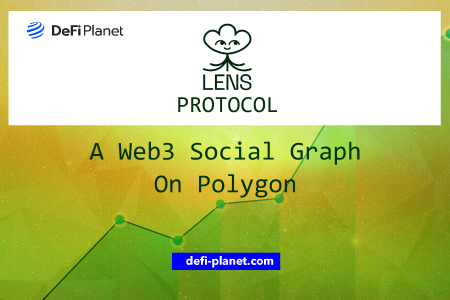Social media has become an essential component of the digital age, transforming how we communicate with one another. It enables us to stay in touch with friends who live far away, communicate with one another, and access an infinite quantity of knowledge. It also allows us to learn about what is happening in the world in real-time.
Most well-known social media sites are centralized and do not give consumers complete control over their social connections. With Web2 social media platforms, there is a risk of user data privacy and vulnerability.
Web2 social media platforms collect and store user data by tracking and documenting user activity. The social graph, a critical component of social media, is made up of these recorded user details.
A social graph is a data structure that depicts the connections between social network users and the people, places, and objects with whom they interact.
A social graph represents the relationships between individuals or entities in a social network. Because the data is stored centrally on the platform, users of Web2 social media platforms do not own the data recorded on the social graph.
Web3 intends to address the issue of centralization. As a result, social media systems based on Web3 technology being developed today are altering social media paradigms.
In January 2022, when the Lens Protocol team published an open letter expressing the importance of Web3-native social media, thousands of people signed in anticipation.
Web3 social graphs such as Lens Protocol have enabled people to own and fully control their information, creating a decentralized social graph.
Lens Protocol, which is rapidly gaining traction among passionate Web3 users, aims to bridge these centralized gaps in the social media industry.
This article comprehensively examines the Lens Protocol; a Web3 Social Graph built on the Polygon blockchain, how it functions, its features and benefits, and its prospects.
What is Lens Protocol?
Lens Protocol is a decentralized social graph built on the Polygon Proof-of-Stake blockchain. The protocol was developed by the Aave team.
The Lens protocol is a user-owned, composable, and decentralized social graph that enables developers to create their own decentralized social media platforms. It was created using blockchain technology, NFTs, and smart contracts to replicate social network features in a Web3 environment.
Lens Protocol prioritizes the Web3 creator economy, empowering content creators to genuinely own their material and followers. Users of the Lens Protocol can publish, share comments, update profiles, follow friends’ profiles, and perform other similar actions, just like on many other Web2 social networking platforms.
How Does the Lens Protocol Function?
The Lens Protocol creates a decentralized graph database (dGDB) that contains all the data related to the nodes, edges, and different aspects of the graph. In other words, these graphs display both the network’s members and their connections.
All this storage is done in two separate sections, one on-chain on Polygon and the other using decentralized systems such as IPFS, Arweave, or even centralized storage systems like Amazon S3. However, all this is done under encrypted and digitally signed data schemes to prevent wrong or improper usage.
Creators who want to launch their own social media network on Web3 can use Lens Protocol’s social graph, which is based on an open-source and composable framework. The social environment surrounding them as a result of user interactions is represented by user profiles through NFTs that change over time.
The Lens Protocol was constructed using a modular approach and is based on the Ethereum scaling solution Polygon. This allows for the future implementation of new features without affecting existing user data.
Furthermore, with a non-fungible twist, the Lens Protocol allows many social media features you’ve grown accustomed to, such as commenting and resharing.
Core Components of Lens Protocol
- Profile NFTs: This is the primary feature of the Lens Protocol. Each profile receives a unique NFT. Profile NFTs are dynamic, composable, non-custodial, and permissionless. They save the history of each user’s posts, comments, mirrors, and other content. If you want to manage numerous social media profiles, a wallet address can hold more than one profile NFT.
- Follow NFTs: When you follow someone on Lens Protocol, you are automatically minted a Follow NFT. These NFTs have a special token ID that is both useful and rare by nature. Follow NFTs can even be sold on an open market and have a variety of applications.
- Publication: The term “publication” is what Lens Protocol uses to describe the content. This tool allows users to produce whatever kind of content they want, including music, images, videos, and more. Making posts straight to your Profile NFT ensures that whatever content you create is yours.
- Collect: Anyone can use this function to buy publications from other users based on the price and specifications defined by the original owners. Once the owner has configured a collect module, subscribers can create NFTs linked to each publication’s content URI. This makes it possible to curate material on the blockchain.
- Mirror: With the mirror feature, users can re-share a post and get paid when someone else collects the original content.
Unique Features of Lens Protocol
- Tokenization of produced content: The Lens Protocol and its content are driven by dynamic Profile NFTs, offering users direct access to the content creation process and the ability to monetize local content.
- Modularity: This is another important aspect of how Lens Protocol encourages innovation. Modules are contracts with limited scope that adhere to an interface and are whitelisted by the governance. This functionality enables developers to create their social applications for Lens using modular components.
- Lens serves as the back end for several social networking products: The Lens Protocol is a framework for creating decentralized social networking applications rather than a decentralized social networking service. Lens is user-friendly for developers and makes it simple to build applications that leverage Web3’s capabilities.
- Simple user classification: Content creators can post, share, and comment on content; non-content producers can only follow their favourite bloggers and gather their NFTs.
Benefits of Using the Lens Protocol
Accessible
Anyone interested in developing a new decentralized social media platform can use the Lens Protocol for free.
Free of centralized control or third-party interference
The Lens Protocol’s permissionless connectivity creates a censorship-resistant environment that makes it difficult for third parties and centralized authorities to remove or restrict any content or profile.
Users have complete control.
Users own and have complete control over their content and data. They can use them in any dApp or social networking platform built with the protocol. Profiles cannot be deleted, censored, or banned by centralized authorities or other third parties.
Flexible to Innovation
Because the platform is open source, anyone can contribute to its development. Developers can contribute to the network, making it more flexible and innovative.
Secure
PeckShield, a leading blockchain security firm, reviewed the Lens Protocol’s code. In addition, they have launched a bug bounty program that will pay developers up to $250,000 for identifying critical bugs.
Applications That Use Lens Protocol
Lens Procol is entirely open-source, so new dApps are constantly being created. The Lens Protocol-powered dApps are listed below.
- Lenster: A decentralized version of Twitter, Lenster allows users to follow others, publish information, and create communities.
- LensFrens is a dApp that suggests people to follow based on their Web3 footprint. This can be helpful when looking for new followers.
- Lenstube is a decentralized video-sharing website similar to YouTube.
- Phaver is a social smartphone app that uses token economics to reward users.
- Alps Finance is a social DeFi investing platform that enables DeFi investors to quickly build their investor brand and community in order to generate long-term revenue.
- Refract is a cryptocurrency discussion forum. Users can discover new initiatives, promote outstanding content, and share novel ideas. The entire experience has been curated by the community.
- Sepana is a search engine built on Lens Protocol.
Lens Protocols expects its platform to be used to develop many more outstanding dApps. The official Lens website lists several fantastic dApp concepts for developers to explore.
Future Outlook of the Lens Protocol
The Lens Protocol is intended to be a dynamic, community-owned social network. The project’s long-term goal is to create a social media ecosystem consisting of numerous small, autonomous sites linked together by the Lens Protocol.
Lens Protocol, currently a multisig Web3 platform, will be converted into a decentralized autonomous organization (DAO) so that users can participate in decision-making. They would be able to vote on proposed new features and modules.
The ecosystem may soon include a native token. The token would be available for purchase and sale, with the proceeds going toward project support.
In Conclusion
- Because most social media platforms are centralized, users do not have complete control over their data and the content they create.
- Social graphs such as the Lens Protocol are used by Web3 social media platforms to address these centralization problems.
- The Lens Protocol is a Web3 social graph built on Polygon.
- It was constructed using a modular approach that provides the resources needed to build a decentralized social media environment.
- This Web3 social graph gives users control over the content they create on social media platforms.
- The Lens Protocol has several advantages, including being easily accessible, decentralized, open to innovation, and secure.
Disclaimer: This article is intended solely for informational purposes and should not be considered trading or investment advice. Nothing herein should be construed as financial, legal, or tax advice. Trading or investing in cryptocurrencies carries a considerable risk of financial loss. Always conduct due diligence.
If you would like to read more articles like this, visit DeFi Planet and follow us on Twitter, LinkedIn, Facebook, and Instagram.
“Take control of your crypto portfolio with MARKETS PRO, DeFi Planet’s suite of analytics tools.”





















